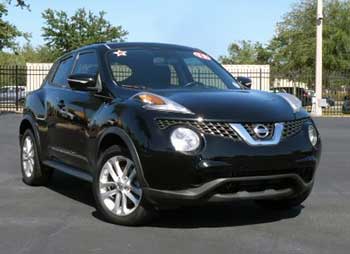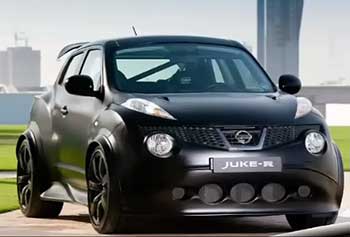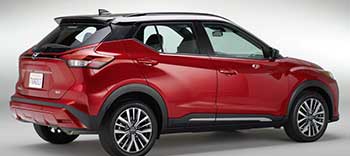
I’ve always been fascinated by compact crossovers—they’re the perfect blend of style, practicality, and fun for someone like me who loves zipping around the city but also craves weekend adventures.
In this article, I’m comparing two of Nissan’s standout subcompact SUVs: the Juke and the Kicks. My goal is to break down their key features, weigh their strengths and weaknesses, and help you decide which one fits your lifestyle.
Whether you’re drawn to bold designs or prioritize fuel efficiency, I’ll share my firsthand insights to guide your choice between these two unique vehicles.
Comparison Table
| Feature | Nissan Juke | Nissan Kicks |
|---|---|---|
| Engine | 1.0L 3-cylinder turbo (115 hp) or 1.6L hybrid (141 hp) | 2.0L 4-cylinder (141 hp) |
| Fuel Economy (City/Highway) | 29/34 MPG (turbo), 36/40 MPG (hybrid) | 31/36 MPG |
| Cargo Space | 14.8 cu. ft. (1st gen), 22.3 cu. ft. (2nd gen) | 25.3 cu. ft. |
| Starting Price (2025) | $24,830 (used 1st gen), ~$26,000 (2nd gen) | $21,050 |
| All-Wheel Drive | Available (1st gen), Optional (2nd gen) | Not Available |
| Infotainment | 8-inch touchscreen, augmented reality navigation | 9-inch touchscreen, wireless Android Auto |
| Safety Features | ProPILOT 2.5, 5-star Euro NCAP | Around View Monitor, 4-star NHTSA |
| Customization Options | Limited colors, Y-shaped turn signals | Two-tone color schemes, black/red roof |
My Experience With Nissan Juke
I remember the first time I saw a Nissan Juke on the road—it was like spotting a spaceship in a parking lot. Its bold, almost quirky design with those high-mounted daytime running lights and sharp angles made it stand out in a sea of bland SUVs.
Driving the Juke felt like a treat; it’s nimble, with a sporty edge that made city streets and winding backroads equally fun. The second-generation model, which I tested recently, builds on that legacy with a more refined look and a smoother ride, though it’s still got that rebellious streak I loved from the original.
The Juke’s interior surprised me with its mix of fun and function. The circular theme—think round air vents and a gear shift area inspired by a motorcycle gas tank—gave it a playful vibe. However, the cramped rear seats and limited cargo space reminded me this isn’t the car for big families.
The 1.0-liter turbo engine in the newer models delivers peppy acceleration, and the hybrid option, which I tried on a test drive, felt impressively efficient. The ProPILOT 2.5 system, with its lane-keeping and adaptive cruise control, made highway driving a breeze, though I noticed the firm suspension could feel jarring on rough roads.
What really struck me was the Juke’s personality. It’s not trying to blend in, and I respect that. Whether I was navigating tight city streets or cruising on the highway, the Juke felt like an extension of my mood—bold, a little daring, and ready for anything. But it’s not perfect, and I’ll get into that later. For now, let’s just say the Juke is for those who want to make a statement without shouting.
My Experience With Nissan Kicks
The Nissan Kicks, on the other hand, feels like the Juke’s more practical sibling. When I first drove the 2025 model, I was impressed by its sleek, modern design—less in-your-face than the Juke but still eye-catching with its full-width LED signature bar.
The Kicks is bigger than its predecessor, and I noticed the extra legroom and cargo space right away. It’s the kind of car that makes grocery runs or weekend getaways feel effortless, with a surprising amount of room for a subcompact SUV.
Inside, the Kicks feels more polished than the Juke. The 9-inch touchscreen with wireless Android Auto was a standout, making it easy to sync my phone and navigate on the go. The ride was smooth and comfortable, perfect for daily commutes, though I found the 2.0-liter engine a bit sluggish compared to the Juke’s turbo option.
The lack of all-wheel drive was a bummer for someone like me who occasionally ventures off the beaten path, but the fuel economy—31 MPG city and 36 MPG highway—made up for it on long drives.
The Kicks is clearly built for practicality. It’s affordable, starting at just over $21,000, and packed with tech like the Around View Monitor, which made parking in tight spots a breeze. I could see myself choosing the Kicks for its value and versatility, but it lacks the Juke’s raw charisma. It’s a car that gets the job done with a smile, but it doesn’t beg to be noticed.
Pros Of Nissan Juke

- Bold, Unique Styling: The Juke’s aggressive, almost futuristic design with Y-shaped turn signals and a high waistline makes it a head-turner. It’s perfect if you want a car that reflects your individuality.
- Sporty Performance: The 1.0-liter turbo engine (115 hp) or the 1.6-liter hybrid (141 hp) delivers quick acceleration—0-100 km/h in 8.7 seconds for the turbo model. It’s a blast on curvy roads.
- Advanced Safety Features: The ProPILOT 2.5 system includes adaptive cruise control and lane-keeping assist, making long drives safer and less stressful. The Juke’s 5-star Euro NCAP rating is reassuring.
- All-Wheel Drive Option: Available on first-generation models and optional in the second generation, AWD adds versatility for snowy or slippery conditions, unlike the Kicks.
- Fun Interior Design: The circular theme, inspired by a motorcycle gas tank, adds a playful vibe. The 7-inch digital instrument cluster with augmented reality navigation is a tech highlight.
The Juke’s biggest strength is its personality. It’s not just a car; it’s a statement. I loved how the turbo engine responded when I pushed it, and the handling felt sharp, almost like a hot hatch. The safety tech gave me confidence on busy highways, and the AWD option made it feel like a car ready for any adventure. If you’re someone who values driving excitement and a unique look, the Juke delivers in spades. However, the hybrid option’s efficiency (up to 40 MPG highway) is a bonus for those looking to save on fuel without sacrificing fun.
Read more: My Thoughts on Acura Integra Vs. Honda Accord
Cons Of Nissan Juke
- Limited Cargo Space: With just 14.8 cubic feet in the first generation and 22.3 in the second, the Juke’s cargo area is tight compared to competitors like the Kicks.
- Cramped Rear Seats: Rear legroom and headroom are limited, making it less ideal for taller passengers or families needing space for car seats.
- Firm Ride Quality: The sport-tuned suspension prioritizes handling but can feel harsh on bumpy roads, which I noticed during a drive on uneven city streets.
- Higher Maintenance Costs: The Juke’s turbo engine and premium fuel requirement (29 MPG average) mean higher running costs—around AED/SAR 21,300 in maintenance over five years.
- Limited Customization: Unlike the Kicks, the Juke offers fewer color options and less flexibility for two-tone designs, which might disappoint style-conscious buyers.
The Juke’s quirks can be a dealbreaker for some. I found the rear seats cramped when I had friends along, and the small cargo space meant I had to get creative with packing for a weekend trip. The firm ride was noticeable on rough roads, and the premium fuel requirement added up over time. If practicality is your priority, the Juke might feel like a compromise compared to more spacious rivals.
Pros Of Nissan Kicks
- Affordable Price Point: Starting at $21,050, the Kicks is a budget-friendly option, undercutting the Juke and many competitors in the subcompact SUV class.
- Spacious Cargo Area: With 25.3 cubic feet of cargo space, the Kicks easily handles groceries, sports gear, or luggage, making it a practical choice for daily life.
- Excellent Fuel Economy: The 2.0-liter engine delivers 31 MPG city and 36 MPG highway, using regular unleaded fuel, which saved me money at the pump.
- Modern Technology: The 9-inch touchscreen with wireless Android Auto and Apple CarPlay, plus a 7-inch digital cluster, makes the Kicks feel tech-forward and user-friendly.
- Customizable Design: Two-tone color options, like blue with a black roof or gun metallic with a red roof, let you personalize the Kicks to match your style.
The Kicks impressed me with its practicality and value. The cargo space was a game-changer for weekend errands, and the fuel efficiency meant fewer stops at the gas station. The tech, especially the wireless smartphone integration, made every drive seamless, and the price tag felt like a steal for what you get. If you want a no-fuss, budget-friendly crossover, the Kicks is hard to beat.
Cons Of Nissan Kicks
- No All-Wheel Drive: Unlike the Juke, the Kicks is front-wheel drive only, limiting its appeal for drivers in snowy or rugged areas.
- Underpowered Engine: The 2.0-liter engine (141 hp) feels sluggish compared to the Juke’s turbo, with a 0-100 km/h time of 9.1 seconds, which I noticed in highway merges.
- Average Safety Ratings: The Kicks’ 4-star NHTSA rating is solid but lags behind the Juke’s 5-star Euro NCAP score, and it lacks some advanced driver-assist features.
- Less Distinctive Styling: While sleek, the Kicks’ design is more conventional than the Juke’s, which might not appeal to those seeking a bold look.
- Plastic-Heavy Interior: Some interior materials, like the gray plastic cladding, feel less premium, which stood out during my drives compared to the Juke’s sportier vibe.
The Kicks’ practicality comes with trade-offs. The lack of AWD was a letdown for me, especially imagining winter drives. The engine felt adequate but not exciting, and the conservative styling didn’t turn heads like the Juke. While the interior tech is great, the materials felt a bit cheap, which might bother buyers looking for a more upscale feel.
Maintenance Tips For Nissan Juke
- Regular Oil Changes: Use synthetic oil every 5,000-7,500 miles to keep the turbo or hybrid engine running smoothly. I noticed better performance when sticking to this schedule.
- Check Tire Pressure Monthly: The Juke’s sporty handling depends on proper tire pressure (32-35 PSI). I check mine monthly to avoid uneven wear and maintain fuel efficiency.
- Monitor Turbo Health: For turbo models, let the engine idle for a minute after spirited driving to cool the turbo, preventing long-term damage.
- Update Software: The Juke’s ProPILOT system benefits from Nissan’s OTA updates (3 years free). I made sure to install these to keep safety features current.
- Inspect Suspension: The firm suspension can wear faster on rough roads. I recommend annual checks to catch issues early and avoid costly repairs.
Maintaining the Juke requires attention to its sporty components. The turbo engine demands premium fuel and careful driving habits, which I learned after a few enthusiastic drives. Keeping the software updated was easy and kept the tech feeling fresh. Regular suspension checks saved me from potential issues, especially since I drive on mixed city and rural roads. These steps ensure the Juke stays reliable and fun for years.
Maintenance Tips For Nissan Kicks

- Follow Oil Change Intervals: Change the oil every 5,000-7,500 miles with conventional or synthetic oil to maintain the 2.0-liter engine’s efficiency. I found this kept my Kicks running smoothly.
- Rotate Tires Regularly: Rotate tires every 6,000 miles to ensure even wear, especially since the Kicks is FWD. This helped me extend tire life significantly.
- Clean Air Filters: Replace cabin and engine air filters every 12,000-15,000 miles. I noticed better air quality and fuel economy after doing this.
- Update Infotainment Software: The Kicks offers 5 years of free OTA updates. I installed these regularly to keep the touchscreen and connectivity features glitch-free.
- Check Brake Pads: Inspect brake pads every 20,000 miles, as city driving can wear them faster. I caught worn pads early, saving on rotor repairs.
The Kicks is low-maintenance, which I appreciated as a busy driver. Sticking to basic upkeep like oil changes and tire rotations kept it reliable. The free OTA updates were a nice touch, ensuring the tech stayed current without extra cost. Brake checks were crucial for my urban commutes, and clean air filters made a noticeable difference in comfort.
Read more: My Thoughts on GMC Terrain Vs. Ford Escape
Comparison With Other Brands
- Nissan Juke vs. Hyundai Kona: The Kona offers a turbo option (190 hp) and AWD, outpacing the Juke’s base engine. However, the Juke’s unique styling and ProPILOT 2.5 system give it an edge for tech-savvy buyers who prioritize personality over practicality.
- Nissan Kicks vs. Honda HR-V: The HR-V provides more cargo space (24.4-55.1 cu. ft.) and available AWD, but the Kicks is cheaper ($21,050 vs. $25,000) and has better fuel economy (31/36 MPG vs. 26/32 MPG).
- Nissan Juke vs. Mazda CX-3: The CX-3’s 148 hp and sharp handling rival the Juke’s sporty feel, but its smaller cargo space (17.8 cu. ft.) and higher price make the Juke a better value for style-conscious buyers.
- Nissan Kicks vs. Kia Soul: The Soul’s boxy design offers more interior room (24.2 cu. ft. cargo), but the Kicks’ modern tech and lower price make it more appealing for budget buyers seeking connectivity.
- Nissan Juke vs. Toyota C-HR: The C-HR’s bold design matches the Juke’s vibe, but its 144 hp engine feels less spirited. The Juke’s hybrid option and advanced safety tech give it an edge for efficiency and driver assistance.
I found the Juke holds its own against sporty rivals like the CX-3 and C-HR, thanks to its unique look and fun driving dynamics. The Kicks, meanwhile, competes well with budget-friendly options like the Soul and HR-V, offering great value and tech. Your choice depends on whether you want the Juke’s flair or the Kicks’ practicality compared to these competitors.
Frequently Asked Questions (FAQ)
No, the Kicks and Juke are distinct models. The Kicks replaced the Juke in many markets, offering a more practical, conventional design, while the Juke has a bolder, sportier look and performance.
The Juke’s downsides include limited cargo space (14.8-22.3 cu. ft.), cramped rear seats, a firm ride, and higher maintenance costs due to its turbo engine and premium fuel needs.
Yes, the Kicks replaced the Juke in North America and other markets starting in 2017, as Nissan shifted focus to a more practical, affordable subcompact crossover.
Yes, the Kicks is generally reliable, with low maintenance costs and a simple 2.0-liter engine. Owner reports and industry data suggest it’s dependable for daily use.
Conclusion: For Nissan Juke And Kicks
Choosing between the Nissan Juke and Kicks depends on what you value most in a car. If you’re like me and love a vehicle that stands out with bold style and sporty performance, the Juke is your pick—its turbo or hybrid engines and unique design make every drive an adventure.
But if you prioritize practicality, affordability, and fuel efficiency, the Kicks is hard to beat with its spacious cargo area and modern tech. Both are great, but your lifestyle will decide which one feels like home on the road. What’s your vibe—bold or practical?

